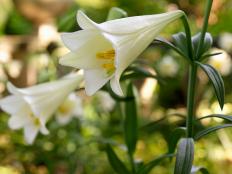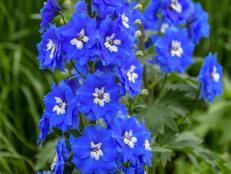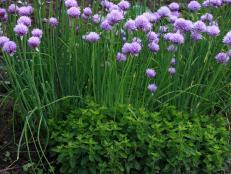How to Plant, Grow and Care for Asiatic Lilies
Available in many sizes and colors, these low-maintenance perennials are an easy way to add texture and bold hues to your garden.

There are dozens of different garden and indoor plants called lilies — peace lilies, daylilies, lily-of-the-valley. But to horticulturists and garden purists, only those in the genus Lilium are true lilies. And within that group, the sub-group of Asiatic lilies may be the easiest and most versatile for home gardeners. They have the broadest color range, grow almost anywhere, bloom early, and mix happily with a variety of other perennials, annuals and shrubs in a colorful garden setting.

'Tiny Rocket' is a dwarf Asiatic lily that was developed in the Netherlands and was originally created for container gardens.
Technically, Asiatic lilies are hybrids derived from a variety of species, according to the North American Lily Society. Bulbs in the group L. asiatica grow plants that can be up to about 4 feet tall, with sturdy stems and large, showy flowers; colors include reds, pinks, plums, oranges, yellows and white, blooming in late spring and early summer. Unlike some other lily species, Asiatic lilies are not fragrant.
Planting Asiatic Lilies
Late summer or fall planting allows the bulb to establish a good root system before it begins to grow the following spring. Asiatic lilies grow best in sun to part shade, in loose, well-drained soil; bulbs sitting in soggy soil are prone to rot. You can improve the soil’s composition by working compost or other organic material into the garden bed.

'Strawberry Custard' is a dwarf Asiatic lily that requires full sun to partial shade and blooms late spring to early summer.
Plant bulbs three times as deep as the bulb’s height, with the flat end down. Some gardeners advise top dressing the soil with fish emulsion or compost tea in the spring, and bone meal when buds appear to encourage larger blooms.
Remove blossoms from Asiatic lilies as they fade. Allow the foliage to remain in the bed until it has turned brown; the old leaves help gather nourishment to the bulb for next year’s blooms.
You can also plant Asiatic lily bulbs in containers in winter to bloom the following spring. Fill a large pot about 1/3 full with sandy potting mix, place the bulbs (flat side down) about two inches apart and cover the bulbs up to their tips with more potting mix. Water the container well, and place it in a cool but frost-free space, such as an unheated garage, greenhouse or garden shed.
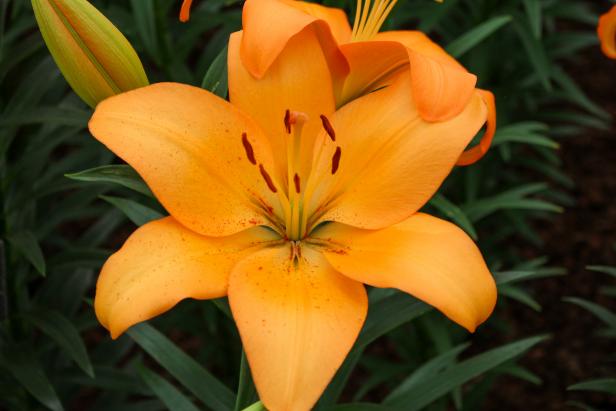
'Navarin' is a Longiflorum and Asiatic hybrid lily that needs full sun to partial shade, blooms in the summer and showcases bright orange petals.
After the danger of frost has passed, move the container outdoors to a sunny or part sunny location. When the lilies begin to grow, add more potting mix, almost up to about an inch below the pot’s rim, and water when the soil begins to look dry. Asiatic lilies in a container should bloom in early summer. Deadhead the blooms after they have faded.
Be aware that lilies are attractive food for some rodents and mammals. Mice may nibble on lily bulbs; deer and rabbits consider lily buds a tasty treat. The plants may also be prone to blights and viruses and can play host to a variety of garden pests including aphids, mites and beetles.
Asiatic Lily Sampler

'Lily Allen' is an Asiatic lily that requires full sun and blooms late spring to early summer.
There are dozens of varieties of Asiatic lilies. Some of the most popular include:
- ‘Mapira’ – 2' to 3' plants with dark maroon flowers.
- ‘Navona’ – Large, pure white flowers on 2' to 3' stems.
- ‘Netty’s Pride’ – Purple flowers with white tips atop 2' tall stems.
- ‘Rosela’s Dream’ – Pink flowers fade from dark at the tips to light in the center on sturdy 3' stems.
- ‘Forever Susan’ – Orange and burgundy flowers on 2' to 3' stems.
46 Varieties of Asiatic Lilies 46 Photos
Find the color and size that's right for your garden.
Lily’s Companions
Asiatic lilies mix well with other garden favorites. Daffodils, hyacinths, tulips, anemones and other spring-flowering bulbs can be the forerunners in a parade of spring and summer blooms in a bed of lilies. Lily bulbs are planted deep in the ground, so shallow-rooted annuals also make good bedfellows. Consider adding annual dianthus, dwarf snapdragons and short varieties of marigolds in the lily bed.
Peonies, poppies, salvia, phlox, daylilies and many other perennials can share a bed with Asiatic lilies, but give them space. Stay away from anything that spreads aggressively or grows so tall that it casts too much shade on its lily neighbors.
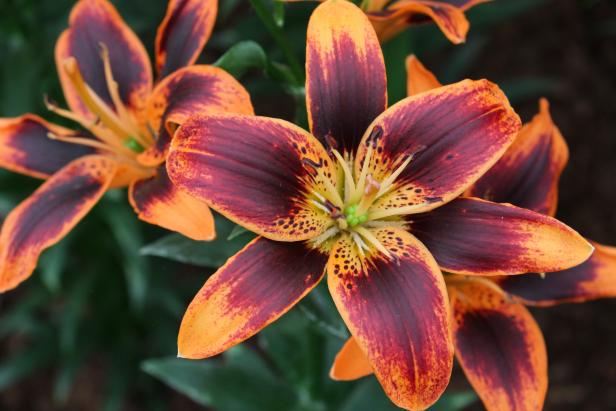
'Forever Susan' is an Asiatic lily that can produce blooms up to 4 inches in diameter and can grow up to 35 inches in height. It is also suitable for containers.










